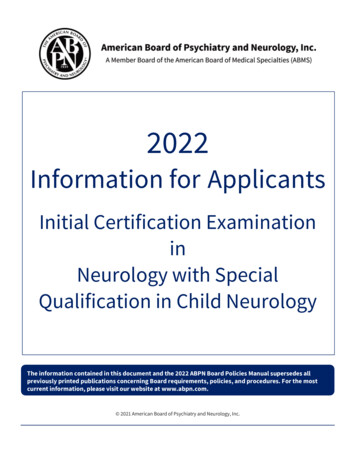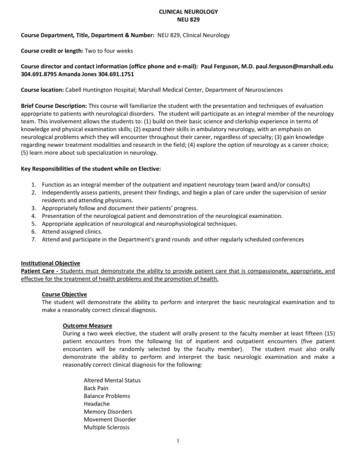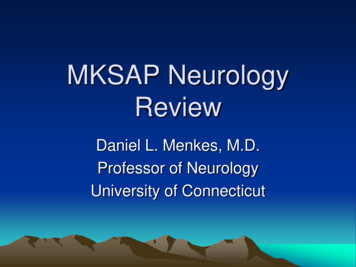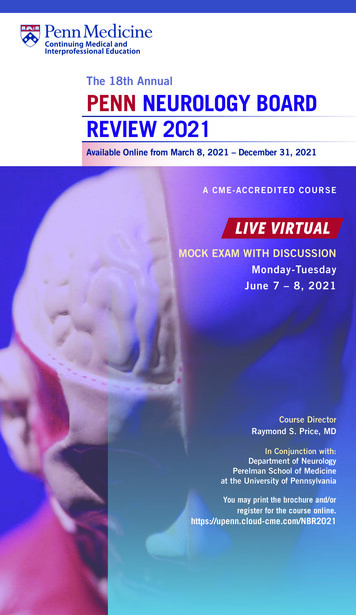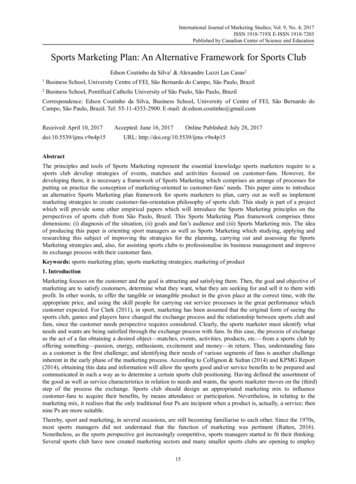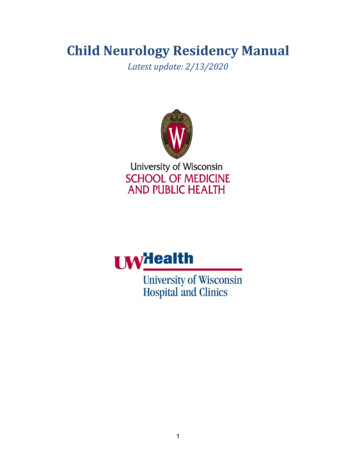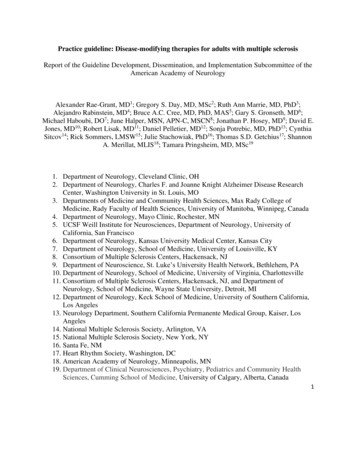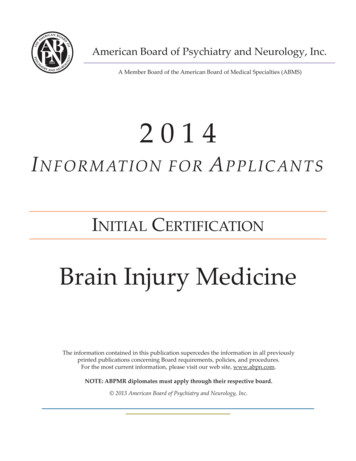
Transcription
Curr Pain Headache Rep (2016) 20: 55DOI 10.1007/s11916-016-0586-4CONCUSSION AND HEAD INJURY (T SEIFERT, SECTION EDITOR)Neurosurgical Emergencies in Sports NeurologyVin Shen Ban 1 & James A. Botros 1 & Christopher J. Madden 1 & H. Hunt Batjer 1Published online: 17 August 2016# The Author(s) 2016. This article is published with open access at Springerlink.comAbstractPurpose of Review Athletic neurosurgical emergencies areinjuries that can lead to mortality or significant morbidityand require immediate recognition and treatment. This reviewarticle discusses the epidemiology of sports-related traumaticbrain injury (TBI) with an attempt to quantify the incidence ofneurosurgical emergencies in sports. Emergencies such as intracranial hemorrhage, second impact syndrome, vascular injuries, and seizures are discussed.Recent Findings The incidence of sports-related TBI presenting to level I or II trauma centers in the USA is about 10 in100,000 population per year. About 14 % of the adult sportsrelated TBIs and 13 % of the pediatric sports-related TBIswere moderate or severe in nature. Patients presenting withheadache and neck pain should prompt further investigationfor cervical spine and vascular injuries. CT angiography isbecoming the modality of choice to screen for blunt cerebrovascular injuries. The treatment of these injuries remainscontroversial.This article is part of the Topical Collection on Concussion and HeadInjury* Vin Shen BanVinShen.Ban@Cantab.netJames A. BotrosJames.Botros@PHHS.orgChristopher J. MaddenChristopher.Madden@UTSouthwestern.eduH. Hunt BatjerHunt.Batjer@UTSouthwestern.edu1Department of Neurological Surgery, University of TexasSouthwestern Medical Center, 5323 Harry Hines Blvd,Dallas, TX 75390-8855, USASummary High-quality evidence in sports-related TBI is lacking. Further research is required to help guide management ofthis increasingly prevalent condition. The role of preventionand education should also not be underestimated.Keywords Neurosurgical emergencies . Sports-related TBI .Traumatic brain injury . Second impact syndromeIntroductionAthletic injuries are common, but injuries involving the brainor spinal cord are less so. Concussions, a subset of mild traumatic brain injuries (mTBI), are the most common type ofhead injury and have received significant recent media attention [1 , 2]. While there can be significant sequelae of a concussion, management generally involves removal from playand supportive care while symptoms are present. The currentarticle focuses on those injuries of the brain and spinal cordthat represent a significant immediate risk of deterioration andwhose recognition and treatment may prevent progressive disability or death. Neurological deficits presenting during anathletic contest should warrant prompt medical attention toevaluate for these conditions that may need immediate care.EpidemiologyIn the USA, TBI was a contributing factor in 30.5 % of injuryrelated deaths [3]. According to the CDC, about 1.7 millionTBIs present to emergency departments annually. The proportion of TBIs related to athletic injuries is unclear. It has beenestimated that 3.8 million sports-related TBIs occur annually,including those who did not seek medical care [4]. It is likelythat the moderate and severe TBIs (as determined by Glasgow
55 Page 2 of 6Coma Scale [GCS] of 9–12 and 3–8, respectively) were morelikely to present to emergency departments compared to themild TBIs (GCS 13–15).Recently, a group from UCSF has utilized data from theNational Sample Program of the National Trauma Data Bankto describe the incidence of pediatric and adult sports-relatedtraumatic brain injury in US Trauma Centers [5 , 6 ]. Theyestimated that 18,310 adult and 11,614 pediatric TBIs presentto level I or level II trauma centers in the USA each year. Thisrepresents an incidence of almost 10 in 100,000 athleticassociated TBIs per year in the USA. About 14 % of the adultsports-related TBIs and 13 % of the pediatric sports-relatedTBIs were moderate or severe in nature. In the adult population, mortality after sports-related TBI was 3.1 %. Of thosesports-related deaths, roller sports (4.1 %) and aquatic sports(7.7 %) were the activities associated with the highest deathrates. In children, the mortality was 0.8 % of sports-relatedTBI. The authors found that the severity of head and extracranial injuries predicted prolonged hospital and ICU stays, medical complications, failure to discharge home, and death, withage and hypotension being additional predictors for the adultpopulation but not for children [5 , 6 ].In Nova Scotia where there was an estimated pediatricpopulation of 200,000, the Nova Scotia Trauma Registry recorded 107 pediatric major trauma cases related to sports overa 13-year period [7 ]. About 52 % were classified as severeTBIs (Abbreviated Injury Scale [AIS]-90 head score 3). Thistranslates into an incidence of approximately 2.2 severe TBIsper 100,000 populations per year. Cycling represented 55 % ofthe major sports-related trauma, and 54 % of the cycling injuries were severe TBIs.Sports-Specific InjuriesSports injuries can be broadly classified according to mechanism (penetrating versus blunt injuries) and structure (vascularversus parenchymal injuries). The mechanisms of injury leading to neurosurgical emergencies are often sports-specific, asdemonstrated by high-profile cases reported in the media(Table 1).Intracranial HemorrhageSports injuries resulting in intracranial hemorrhage such asacute subdural hematoma (ASDH), epidural hematoma(EDH), and intracerebral hemorrhage (ICH) typically occurthrough sports with the potential for high-energy collisionssuch as motorsports (formula racing, rallying), boardsports(skateboarding, snowboarding), and skiing. Patients onanticoagulation are particularly challenging to manage. TheCurr Pain Headache Rep (2016) 20: 55topic of anticoagulation in the neurosurgical patient has recently been extensively reviewed [8].A recent systematic review and meta-analysis of cohortstudies found that in ASDH patients (of all causes, includingsports) who presented with bilateral fixed and dilated pupils,the mortality after undergoing surgery was 66 % while only6.6 % achieved a favorable Glasgow Outcome Scale (GOS)score [9]. In the EDH cohort, the mortality was found to bealmost 30 %, and 54 % achieved a favorable GOS. While agehas been shown to be a predictive factor for poorer outcomes[10], Bage bias in terms of the patient management in certainregions may have confounded this issue [11].Second Impact SyndromeThe concept that a second impact leading to a catastrophicbrain injury after a concussion was thought to be first described by Schneider in 1973 [12, 13]. The term Bsecondimpact was then used by Saunders and Harbaugh in their1984 report of a case of a 19-year-old college football playerwho developed brain swelling leading to death after playingfootball with no apparent trauma [13]. It became clear that thispatient had received a blow to the head 4 days prior and wasstill symptomatic when he resumed contact play. The autopsyfindings led the authors to speculate that the catastrophic brainedema was a result of reduced brain compliance from therecent head injury. Nonetheless, the existence of second impact syndrome (SIS) has previously been challenged [14].A recent systematic review investigated the cases published in the literature to identify unique criteria for assigningthe diagnosis of SIS [15]. Of the eight articles included in theirfinal analysis, the authors found that young adults or adolescents, brain swelling, herniation, and acute subdural hematoma were the common features in most cases. However, theauthors concluded that the development of a uniqueInternational Classification of Diseases (ICD) diagnosisof SIS was not supported by the evidence available inthe literature, citing the overlapping symptoms with various other conditions, the lack of an established timelinebetween the head impacts, and the mixed results of thepresence of imaging findings as reasons. Despite the lackof convincing evidence, an approach of ensuring the resolution of symptoms prior to return to play is advocatedin current return to play guidelines [1 ].Vascular InjuriesThere is no epidemiological literature on vascular injuries thatis specific to the athletic population. Vascular injury will be arare injury in the athletic setting but in the trauma literature,blunt cervical vascular injuries (BCVI) can occur in the setting
Curr Pain Headache Rep (2016) 20: 55Table 1Page 3 of 6 55Non-exhaustive list of high-profile sports-related neurosurgical emergencies based on media reportsCaseYearSportsVladimir Smirnov1982Fencing (foil)Penetrating brain injury through orbitDeathClint Malarchuk1989Ice hockeySevered carotid artery and internal jugular veinGood recoveryChristopher ReeveZachary Lystedt19952006Equestrian (cross country)FootballC1-2 fracture, SCIBilateral subdural hematomaSeverely disabledSeverely disabledRichard ZednikNatasha Richardson20082009Ice hockeySkiing (off-piste)Lacerated external carotid arteryEpidural hematomaGood recoveryDeathMichael Schumacher2013Skiing (off-piste)TBI, exact injuries unknownSeverely disabledof high-energy impacts and can have the potential to lead toembolic stroke and death. These injuries are typically causedby impingement of the vessel by a bony surface, by stretchingor tearing during vigorous rotation of the neck, or by spinal orskull base fractures lacerating the vessel. The resulting intimaltear predisposes to thrombus formation that can lead to completevessel occlusion or distal emboli. Pseudoaneurysms or completetransections are significantly less common types of BCVI.Typically, symptomatic patients present with headaches,neck pain, Horner’s syndrome, or stroke. As headaches andneck pain are common in the TBI population, a high index ofsuspicion for a vascular injury should be present. A review ofheadaches in intracranial and cervical artery dissections wasundertaken in a previous issue of this journal [16]. Patientspresenting with these symptoms after a sports-related TBIshould prompt investigation for cervical spine fracture andBCVI. Cervical spine fracture has previously been shown tobe an independent predictor of blunt vertebral artery injury[17 , 18 ]. Other high-risk features that should warrant screening for BCVI have been defined in the Denver criteria [17 ,19 , 20, 21]. These include basilar skull fractures, Lefort II andIII fractures, and penetrating injuries. The Denver group hasalso introduced a grading scale for BCVIs which correlatedwith the risk of stroke—grade I (luminal irregularity or dissection with 25 % luminal stenosis), grade II (dissection orintramural hematoma with 25 % luminal stenosis,intraluminal thrombus, or raised intimal flap), grade III(pseudoaneurysm), grade IV (occlusion), and grade V(transection) [19 ].Recent literature suggests that cerebral infarctions may occur prior to presentation or shortly after arrival [22–27].Cothren and colleagues argued for comprehensive screeningand early diagnosis based on their findings of stroke in 21 %of their BCVI patients [28], although that percentage varieswith other series [22–26, 29]. Out of their cohort of 301 patients with BCVIs, 3.7 % were due to snowboarding, and1.7 % were due to bicycling. While the authors acknowledgedthe subgroup of 11 patients who presented with neurologicsymptoms of stroke within 1–2 h, they have noted that anothersubgroup of 34 patients also exist where these patientsInjuryOutcomeremained asymptomatic in the first 2 h, but subsequently developed stroke with a mean time of 75 h.In terms of screening modality, digital subtraction angiography (DSA) is considered to be the gold standard diagnostictest, although computed tomography angiography (CTA) hasbeen shown to have a good sensitivity as a screening modalityand is used in many institutions [30 , 31].The most appropriate treatment of vascular injury remainsa topic of debate. Anticoagulant and antiplatelet agents carrythe risk of hemorrhagic complications especially in a traumacohort but may lessen the risk of developing a thrombus andan ischemic complication [32]. Endovascular interventionmay have a role in the treatment of pseudoaneurysms, butconcerns have been raised about the procedure-related complications [33]. Open surgical repair is only rarely warranted.Guidelines for the management of BCVI have been publishedin the trauma literature [34 , 35 ].SeizuresSeizure is perhaps one of the most dramatic manifestations of acute sports-related head injury. While rare, convulsive episodes following mild traumatic brain injuryrepresent an important diagnostic dilemma. It is estimatedthat up to one in 70 patients with concussion experience aconcussive convulsion immediately following impact[36]. This may include an immediate tonic phase followedby a clonic or myoclonic phase lasting several minutes.Post-ictal state is either absent or very brief. Previouslyreferred to as impact seizures, these episodes are morefrequently referred to as concussive convulsion to emphasize the non-epileptic nature of these events [37].Although the exact pathophysiology of these events isunclear, the dominant theory incorporates the concept ofrapid, non-discriminate release of excitatory neurotransmitters at the time of impact, followed shortly by spreading depression. This is believed to result in loss of corticalinhibition, which in turn results in transient functionaldecerebration, which manifests as concussive convulsion
55 Page 4 of 6[36, 38 ]. Studies have demonstrated that there is no correlation between the presence of concussive convulsionand adverse clinical or radiographic outcome, and thereis no increased risk of post-traumatic epilepsy. Therefore,no specific treatment is necessary beyond immediate supportive care and airway protection. There is no indicationfor anticonvulsant therapy [39]. Due to the benign natureof concussive convulsion, it is not considered a concussion modifier for the purposes of classifying concussionseverity and guiding return to play or other postconcussion counseling [1 ].Seizures may also represent a manifestation of an underlying parenchymal brain injury however. In the prehospital setting, prolonged seizure activity may indicate amore severe head injury, potentially with structural braininjury such as intracranial contusion or extra-axial hematoma. Prolonged seizure activity warrants hospital transfer and cranial imaging.Post-traumatic seizures are typically divided into earlyseizures, occurring within 1 week of injury, and late seizures, occurring more than 1 week after injury. Estimatedrisk of post-traumatic seizures varies from 2 to 25 % andrisk increases with head injury severity [40]. Prolongedunconsciousness or post-traumatic amnesia, particularlybeyond 24 h, are both recognized as risk factors [41].Penetrating injury has the strongest correlation withpost-traumatic seizures, with estimates up to 53 %.Patients with severe or penetrating head injury shouldreceive seizure prophylaxis for at least 7 days. It shouldbe recognized, however, that this decreases the risk ofearly seizures but does not significantly reduce the riskof late seizures or post-traumatic epilepsy [40, 41].Neck Injuries, Penetrating Injuries, CSF Leak,Incidental FindingsCervical spine fractures are a concern in sports injuries. Asdiscussed in the section on vascular injuries above, the suddenonset of severe neck pain should raise suspicion for vascularinjuries, cervical spine fractures, and ligamentous injuries.These patients should be stabilized according to the advancedtrauma life support (ATLS) protocol immediately, with specific emphasis on head and neck immobilization. They should beremoved from the field of play and transferred to the emergency room as soon as possible. Occasionally, blows to thehead have concomitant transfer of forces to the cervicalspine that may present with spinal concussion-like symptoms. Due to the potential for unstable cervical spine injuries, any patient with a neurological deficit, even transient, should be treated as if they also have a cervicalspine injury until proven otherwise [42, 43].Curr Pain Headache Rep (2016) 20: 55Penetrating cranial or spinal injuries need immediatehospital transfer for definitive care. In general, the penetrating object should not be removed but should be stabilized for transport. Cerebrospinal fluid (CSF) leak(otorrhea or rhinorrhea) may be associated with penetrating injury or with fractures through the skull base. Anathlete with drainage from the ear or nose consistent witha CSF leak will require immediate medical evaluation dueto the high risk of meningitis.A proportion of sports injuries may reveal incidental findings in the brain and spinal cord, or trigger the symptom onsetof these lesions. For example, an AVM might bleed after ablow to the head. An athlete with a type I Chiari malformationmay experience Lhermitte’s sign (masquerading asBstingers ) or may be quadriplegic from head trauma.Despite the rare occurrence of these scenarios, there shouldbe a low threshold for transfer to an emergency room forfurther evaluation and management.Concluding remarksAs we begin to further our understanding of TBIs, therole of prevention should also be acknowledged. One ofthe focuses of this area is on the use of helmets. Rapiddesign and technological improvements have given riseto a range of measurements to evaluate the protectiveeffect of these helmets [44]. How these translate intothe prevention of head injuries remains to be seen. Therole of education, rule changes, and legislation shouldalso not be underestimated in the quest to preventsports-related TBIs [45].While neurosurgical emergencies in sports can havedevastating consequences, the relative rarity of theseemergencies in the athletic setting has resulted in fewtreatment recommendations specific to athletics.Prospective longitudinal population studies and TBI injury registries should be encouraged. In the meantime, itis reasonable to extrapolate principles from the nonathletic trauma literature to support decisions regardingdiagnosis and treatment. Any athlete exhibiting neurological symptoms on the field or after an athletic contestrequires an expeditious medical evaluation.Compliance with Ethical StandardsConflict of Interest Vin Shen Ban, James A. Botros, and Christopher J.Madden declare that they have no conflict of interest.H. Hunt Batjer is a co-chair of the National Football League (NFL)Head, Neck, and Spine Committee and is a co-chair of the Texas Institutefor Brain Injury and Repair (TIBIR).Human and Animal Rights and Informed Consent This article doesnot contain any studies with human or animal subjects performed by anyof the authors.
Curr Pain Headache Rep (2016) 20: 55Open Access This article is distributed under the terms of the CreativeCommons Attribution 4.0 International License (http://creativecommons.org/licenses/by/4.0/), which permits unrestricted use,distribution, and reproduction in any medium, provided you give appropriate credit to the original author(s) and the source, provide a link to theCreative Commons license, and indicate if changes were made.Page 5 of 6 5511.12.13.14.ReferencesPapers of particular interest, published recently, have beenhighlighted as: Of importance Of major importance1. McCrory P, Meeuwisse WH, Aubry M, Cantu B, Dvorak J,Echemendia RJ, et al. Consensus statement on concussion in sport:the 4th International Conference on Concussion in Sport held inZurich, November 2012. J Am Coll Surg. 2013;216(5):e55–71.The latest international consensus statement on sports concussion. This consensus statement highlights the lack of high quality evidence for the diagnosis and management of sports concussion. An updated concussion statement is due soon.2. Ban VS, Madden CJ, Bailes JE, Hunt Batjer H, Lonser RR. Thescience and questions surrounding chronic traumatic encephalopathy. Neurosurg Focus. 2016;40(4):E15.3. Faul M, Xu L, Wald MM, VG C. Traumatic brain injury in theUnited States: emergency department visits, hospitalizations, anddeaths, 2002-2006. Centers for Disease Control and Prevention,National Center for Injury Prevention and Control. Atlanta, GA;2010.4. Langlois JA, Rutland-Brown W, Wald MM. The epidemiology andimpact of traumatic brain injury: a brief overview. J Head TraumaRehabil. 2006;21(5):375–8.5. Yue JK, Winkler EA, Burke JF, Chan AK, Dhall SS, Berger MS,et al. Pediatric sports-related traumatic brain injury in United Statestrauma centers. Neurosurg Focus. 2016;40(4):E3. Analysis of pediatric sports-related TBI from a large national traumaregistry.6. Winkler EA, Yue JK, Burke JF, Chan AK, Dhall SS, Berger MS,et al. Adult sports-related traumatic brain injury in United Statestrauma centers. Neurosurg Focus. 2016;40(4):E4. Similar studyfrom the same group as the article above, but focusing onadults.7. Green RS, Butler MB, Kureshi N, Erdogan M. A retrospectiveevaluation of pediatric major trauma related to sport and recreational activities in Nova Scotia. CJEM. 2016;18(2):106–11. Anothertrauma registry study, with a focus on the pediatric populationin one of the most densely populated provinces in Canada8. Le Roux P, Pollack Jr CV, Milan M, Schaefer A. Race against theclock: overcoming challenges in the management of anticoagulantassociated intracerebral hemorrhage. J Neurosurg.2014;121(Suppl):1–20.9. Scotter J, Hendrickson S, Marcus HJ, Wilson MH. Prognosis ofpatients with bilateral fixed dilated pupils secondary to traumaticextradural or subdural haematoma who undergo surgery: a systematic review and meta-analysis. Emerg Med J. 2015;32(8):654–9.10. Susman M, DiRusso SM, Sullivan T, Risucci D, Nealon P, Cuff S,et al. Traumatic brain injury in the elderly: increased mortality andworse functional outcome at discharge despite lower injury severity.J Trauma. 2002;53(2):219–23. discussion 23-4.15.16.17. 18. 19. 20.21.22.23.24.25.26.27.Kirkman MA, Jenks T, Bouamra O, Edwards A, Yates D, WilsonMH. Increased mortality associated with cerebral contusions following trauma in the elderly: bad patients or bad management? JNeurotrauma. 2013;30(16):1385–90.Schneider R. Head and neck injuries in football: mechanisms, treatment, and prevention. Baltimore: Williams & Wilkins Co; 1973.Saunders RL, Harbaugh RE. The second impact in catastrophiccontact-sports head trauma. JAMA. 1984;252(4):538–9.McCrory P. Does second impact syndrome exist? Clin J Sport Med.2001;11(3):144–9.Hebert O, Schlueter K, Hornsby M, Van Gorder S, Snodgrass S,Cook C. The diagnostic credibility of second impact syndrome: asystematic literature review. J Sci Med Sport. 2016. doi:10.1016/j.jsams.2015.12.517.Sheikh HU. Headache in intracranial and cervical artery dissections.Curr Pain Headache Rep. 2016;20(2):8.Biffl WL, Moore EE, Offner PJ, Brega KE, Franciose RJ, Elliott JP,et al. Optimizing screening for blunt cerebrovascular injuries. Am JSurg. 1999;178(6):517–22. The modified Denver criteria forBCVI screening. High risk factors for blunt carotid injuriesinclude GCS 6, petrous fracture, diffuse axonal injury, andLeFort II or III fractures. Cervical spine fractures was identified as a high risk factor for blunt vertebral artery injury.Franz RW, Willette PA, Wood MJ, Wright ML, Hartman JF. Asystematic review and meta-analysis of diagnostic screening criteriafor blunt cerebrovascular injuries. J Am Coll Surg. 2012;214(3):313–27. A recent systematic review and meta-analysis of diagnostic screening criteria for blunt cerebrovascular injuries.Cervical and thoracic spine injuries were found to be significantpredictors of BCVI.Biffl WL, Moore EE, Offner PJ, Brega KE, Franciose RJ, BurchJM. Blunt carotid arterial injuries: implications of a new gradingscale. J Trauma. 1999;47(5):845–53. The article on the BCVIgrading scale by the Denver group.Biffl WL, Moore EE, Elliott JP, Ray C, Offner PJ, Franciose RJ,et al. The devastating potential of blunt vertebral arterial injuries.Ann Surg. 2000;231(5):672–81.Biffl WL, Moore EE, Offner PJ, Burch JM. Blunt carotid and vertebral arterial injuries. World J Surg. 2001;25(8):1036–43.Scott WW, Sharp S, Figueroa SA, Madden CJ, Rickert KL. Clinicaland radiological outcomes following traumatic grade 1 and 2 vertebral artery injuries: a 10-year retrospective analysis from a level 1trauma center. J Neurosurg. 2014;121(2):450–6.Scott WW, Sharp S, Figueroa SA, Eastman AL, Hatchette CV,Madden CJ, et al. Clinical and radiological outcomes followingtraumatic grade 3 and 4 vertebral artery injuries: a 10-year retrospective analysis from a level I trauma center. The Parkland Carotidand vertebral artery injury survey. J Neurosurg. 2015;122(5):1202–7.Scott WW, Sharp S, Figueroa SA, Eastman AL, Hatchette CV,Madden CJ, et al. Clinical and radiographic outcomes followingtraumatic grade 1 and 2 carotid artery injuries: a 10-year retrospective analysis from a level I trauma center. The Parkland Carotid andvertebral artery injury survey. J Neurosurg. 2015;122(5):1196–201.Scott WW, Sharp S, Figueroa SA, Eastman AL, Hatchette CV,Madden CJ, et al. Clinical and radiographic outcomes followingtraumatic grade 3 and 4 carotid artery injuries: a 10-year retrospective analysis from a level 1 trauma center. The Parkland Carotid andvertebral artery injury survey. J Neurosurg. 2015;122(3):610–5.Griessenauer CJ, Fleming JB, Richards BF, Cava LP, Cure JK,Younan DS, et al. Timing and mechanism of ischemic stroke dueto extracranial blunt traumatic cerebrovascular injury. J Neurosurg.2013;118(2):397–404.Mayberry JC, Brown CV, Mullins RJ, Velmahos GC. Bluntcarotid artery injury: the futility of aggressive screening anddiagnosis. Arch Surg. 2004;139(6):609–12. discussion 12-3.
55 Page 6 of 628.29.30. 31.32.33.34. 35. Cothren CC, Biffl WL, Moore EE, Kashuk JL, Johnson JL.Treatment for blunt cerebrovascular injuries: equivalence ofanticoagulation and antiplatelet agents. Arch Surg. 2009;144(7):685–90.Stein DM, Boswell S, Sliker CW, Lui FY, Scalea TM. Blunt cerebrovascular injuries: does treatment always matter? J Trauma.2009;66(1):132–43. discussion 43-4.Roberts DJ, Chaubey VP, Zygun DA, Lorenzetti D, Faris PD, BallCG, et al. Diagnostic accuracy of computed tomographic angiographyfor blunt cerebrovascular injury detection in trauma patients: a systematic review and meta-analysis. Ann Surg. 2013;257(4):621–32. Epub2013/03/09. A systematic review and meta-analysis of eight studiesto quantify the diagnostic accuracy of CTA compared to catheterangiogram for detecting BCVI. The authors found that CTA hashigh specificity but low sensitivity for this purpose.Shahan CP, Magnotti LJ, Stickley SM, Weinberg JA, Hendrick LE,Uhlmann RA, et al. A safe and effective management strategy forblunt cerebrovascular injury: avoiding unnecessary anticoagulationand eliminating stroke. J Trauma Acute Care Surg. 2016;80(6):915–22.Shahan CP, Magnotti LJ, McBeth PB, Weinberg JA, Croce MA,Fabian TC. Early antithrombotic therapy is safe and effective inpatients with blunt cerebrovascular injury and solid organ injuryor traumatic brain injury. J Trauma Acute Care Surg. 2016;81(1):173–7.Cothren CC, Moore EE, Ray Jr CE, Ciesla DJ, Johnson JL, MooreJB, et al. Carotid artery stents for blunt cerebrovascular injury: risksexceed benefits. Arch Surg. 2005;140(5):480–5. discussion 5-6.Bromberg WJ, Collier BC, Diebel LN, Dwyer KM, Holevar MR,Jacobs DG, et al. Blunt cerebrovascular injury practice managementguidelines: the Eastern Association for the Surgery of Trauma. JTrauma. 2010;68(2):471–7. CVI screening and treatment guidelines by the Eastern Association for the Surgery of Trauma.Biffl WL, Cothren CC, Moore EE, Kozar R, Cocanour C, DavisJW, et al. Western Trauma Association critical decisions in trauma:screening for and treatment of blunt cerebrovascular injuries. JCurr Pain Headache Rep (2016) 20: 5536.37.38. 39.40.41.42.43.44.45.Trauma. 2009;67(6):1150–3. BCVI screening and treatmentguidelines by the Western Trauma Association.McCrory PR, Berkovic SF. Concussive convulsions. Incidence insport and treatment recommendations. Sports Med. 1998;25(2):131–6.Perron AD, Brady WJ, Huff JS. Concussive convulsions: emergency department assessment and management of a frequently misunderstood entity. Acad Emerg Med. 2001;8(3):296–8.Giza CC, Hovda DA. The new neurometabolic cascade of concussion. Neurosurgery. 2014;75 Suppl 4:S24–33. An excellent andcomprehensive review on the mechanisms of metabolic injuryand pathophysiology of concussions.Nass RD, Elger CE, Fink GR, Burghaus L. Concussive convulsions: seizure or no seizure? Fortschr Neurol Psychiatr.2011;79(11):655–9. Kommotionelle Konvulsionen: EpileptischerAnfall oder nicht?.Garga N, Lowenstein DH. Posttraumatic epilepsy: a major problemin desperate need of major advances. Epilepsy Curr. 2006;6(1):1–5.Ferguson PL, Smith GM, Wannamaker BB, Thurman DJ,Pickelsimer EE, Selassie AW. A population-based study of risk ofepilepsy after hospitalization for traumatic brain injury. Epilepsia.2010;51(5):891–8.Leddy JJ, Baker JG, Merchant A, Picano J, Gaile D, Matuszak J,et al. Brain or strain? Symptoms alone do not distinguish physiologic concussion from cervical/vestibular injury. Clin J Sport Med.2015;25(3):237–42.Jagannathan J, Dumont AS, Prevedello DM, Shaffrey CI, Jane JrJA. Cervical spine injuries in pediatric athletes: mechanisms andmanagement. Neurosurg Focus. 2006;21(4).Hoshizaki TB, Post A, Oeur RA, Brien SE. Current and futureconcepts in helmet and sports injury prevention. Neurosurgery.2014;75 Suppl 4:S136–48.Ellenbogen RG, Berger MS, Batjer HH. The National FootballLeague and concussion: leading a culture change in contact sports.World Neurosurgery. 2010;74(6):560–5.
Neurosurgical Emergencies in Sports Neurology . for cervical spine and vascular injuries. CT angiography is becoming the modality of choice to screen for blunt cerebro- . Dallas, TX 75390-8855, USA Curr Pain Headache Rep (2016) 20: 55 DOI 10.1007/s11916-016-0586-4
